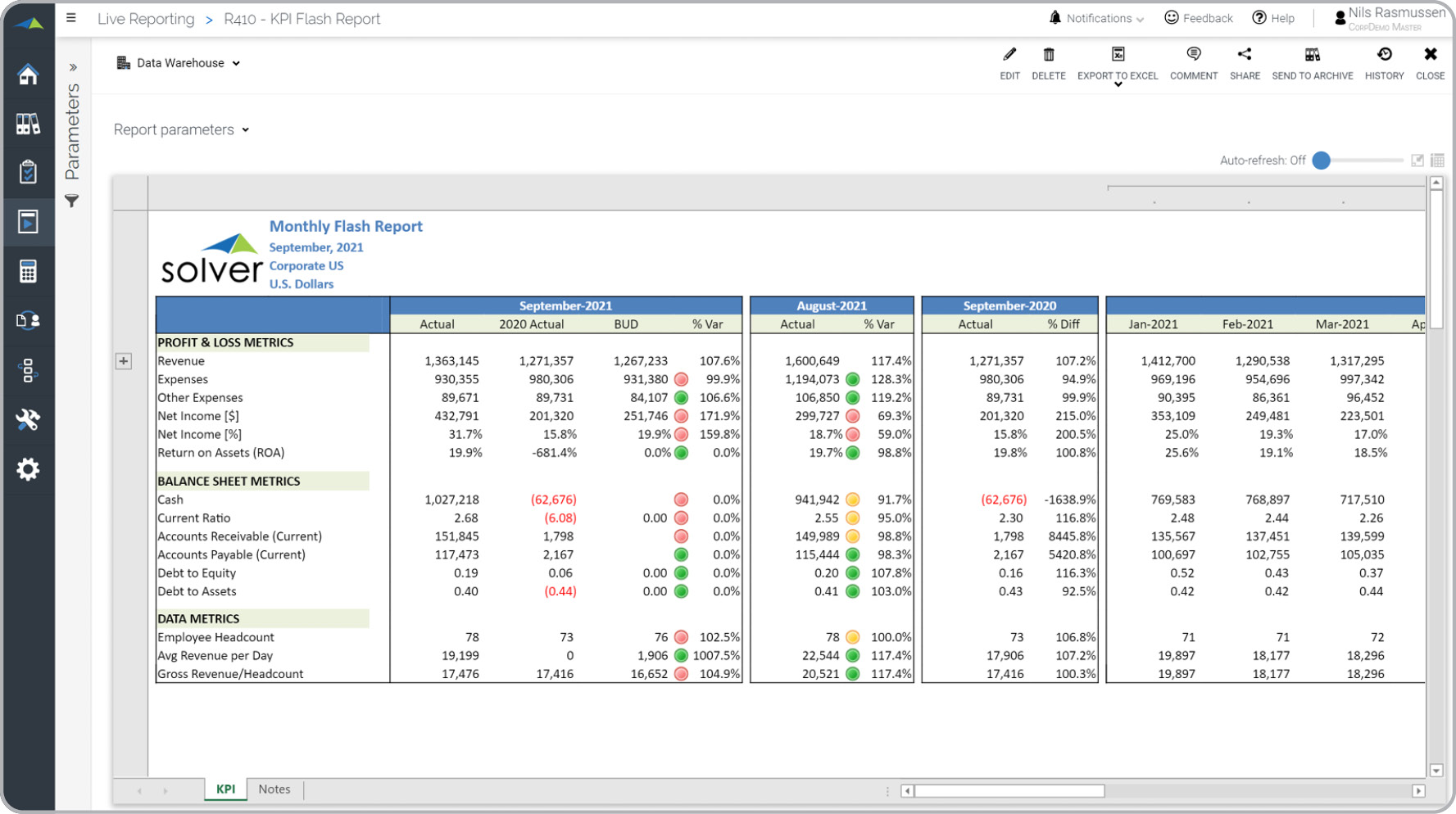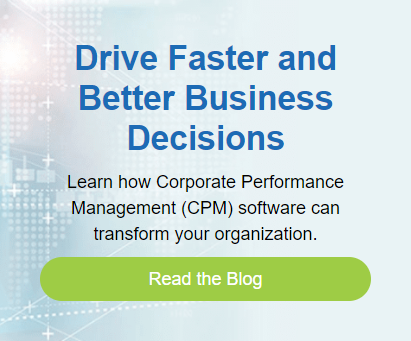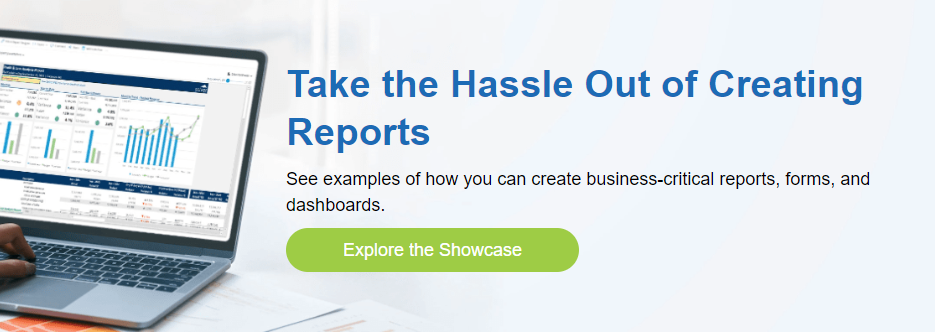Related Posts
BLOG HOME
- Subscription Billing Auto Forecast for SaaS Companies using Dynamics 365 Business Central
- Top 50 Opportunities Report for SaaS Companies using Dynamics 365 BC
- Subscription Sales by Contract Length Report for SaaS Companies using Dynamics 365 Business Central
- Multi-Year Profit & Loss Forecast Model for SaaS Companies using Dynamics 365 Business Central
- Lead Target Model for SaaS Companies using Dynamics 365 Business Central
Monthly Flash Report
What is
a
Monthly Flash Report
? Flash Reports are considered management reports and are often used by executives and finance managers to quickly get a picture of most of the company's important metrics. Some key functionality in this type of dashboard report shows actual and budget data for the current month, last month, same period last year, as well as, for each individual month this year. Variance columns with traffic lights help drive attention to outliers. The rows show key statistical and financial metrics. You will find an example of this type of dashboard report below.
Purpose of
Monthly Flash Reports Companies and organizations use Monthly Flash Reports to easily detect outliers and exceptions in their key metrics. When used as part of good business practices in a Financial Planning & Analysis (FP&A) Department, a company can improve its ability to quickly detect and react to problems or opportunities, as well as, reduce the chances that a situation arises unseen until it is too late.
Monthly Flash Report
Example Here is an example of a Monthly Flash Report with financial and statistical metrics. [caption id="" align="alignnone" width="1777"]
 Monthly Flash Report Example[/caption] You can find hundreds of additional examples
here.
Who Uses This Type of
Dashboard report
? The typical users of this type of dashboard report are: Executives and Managers.
Other
Dashboard report
s Often Used in Conjunction with
Monthly Flash Reports Progressive Financial Planning & Analysis (FP&A) Departments sometimes use several different Monthly Flash Reports, along with financial reports, operational reports, dashboards and other management and control tools.
Where Does the Data for Analysis Originate From? The Actual (historical transactions) data typically comes from enterprise resource planning (ERP) systems like: Microsoft Dynamics 365 (D365) Finance, Microsoft Dynamics 365 Business Central (D365 BC), Microsoft Dynamics AX, Microsoft Dynamics NAV, Microsoft Dynamics GP, Microsoft Dynamics SL, Sage Intacct, Sage 100, Sage 300, Sage 500, Sage X3, SAP Business One, SAP ByDesign, Acumatica, Netsuite and others. In analyses where budgets or forecasts are used, the planning data most often originates from in-house Excel spreadsheet models or from professional corporate performance management (CPM/EPM) solutions.
What Tools are Typically used for Reporting, Planning and Dashboards? Examples of business software used with the data and ERPs mentioned above are:
Monthly Flash Report Example[/caption] You can find hundreds of additional examples
here.
Who Uses This Type of
Dashboard report
? The typical users of this type of dashboard report are: Executives and Managers.
Other
Dashboard report
s Often Used in Conjunction with
Monthly Flash Reports Progressive Financial Planning & Analysis (FP&A) Departments sometimes use several different Monthly Flash Reports, along with financial reports, operational reports, dashboards and other management and control tools.
Where Does the Data for Analysis Originate From? The Actual (historical transactions) data typically comes from enterprise resource planning (ERP) systems like: Microsoft Dynamics 365 (D365) Finance, Microsoft Dynamics 365 Business Central (D365 BC), Microsoft Dynamics AX, Microsoft Dynamics NAV, Microsoft Dynamics GP, Microsoft Dynamics SL, Sage Intacct, Sage 100, Sage 300, Sage 500, Sage X3, SAP Business One, SAP ByDesign, Acumatica, Netsuite and others. In analyses where budgets or forecasts are used, the planning data most often originates from in-house Excel spreadsheet models or from professional corporate performance management (CPM/EPM) solutions.
What Tools are Typically used for Reporting, Planning and Dashboards? Examples of business software used with the data and ERPs mentioned above are:
 Monthly Flash Report Example[/caption] You can find hundreds of additional examples
here.
Who Uses This Type of
Dashboard report
? The typical users of this type of dashboard report are: Executives and Managers.
Other
Dashboard report
s Often Used in Conjunction with
Monthly Flash Reports Progressive Financial Planning & Analysis (FP&A) Departments sometimes use several different Monthly Flash Reports, along with financial reports, operational reports, dashboards and other management and control tools.
Where Does the Data for Analysis Originate From? The Actual (historical transactions) data typically comes from enterprise resource planning (ERP) systems like: Microsoft Dynamics 365 (D365) Finance, Microsoft Dynamics 365 Business Central (D365 BC), Microsoft Dynamics AX, Microsoft Dynamics NAV, Microsoft Dynamics GP, Microsoft Dynamics SL, Sage Intacct, Sage 100, Sage 300, Sage 500, Sage X3, SAP Business One, SAP ByDesign, Acumatica, Netsuite and others. In analyses where budgets or forecasts are used, the planning data most often originates from in-house Excel spreadsheet models or from professional corporate performance management (CPM/EPM) solutions.
What Tools are Typically used for Reporting, Planning and Dashboards? Examples of business software used with the data and ERPs mentioned above are:
Monthly Flash Report Example[/caption] You can find hundreds of additional examples
here.
Who Uses This Type of
Dashboard report
? The typical users of this type of dashboard report are: Executives and Managers.
Other
Dashboard report
s Often Used in Conjunction with
Monthly Flash Reports Progressive Financial Planning & Analysis (FP&A) Departments sometimes use several different Monthly Flash Reports, along with financial reports, operational reports, dashboards and other management and control tools.
Where Does the Data for Analysis Originate From? The Actual (historical transactions) data typically comes from enterprise resource planning (ERP) systems like: Microsoft Dynamics 365 (D365) Finance, Microsoft Dynamics 365 Business Central (D365 BC), Microsoft Dynamics AX, Microsoft Dynamics NAV, Microsoft Dynamics GP, Microsoft Dynamics SL, Sage Intacct, Sage 100, Sage 300, Sage 500, Sage X3, SAP Business One, SAP ByDesign, Acumatica, Netsuite and others. In analyses where budgets or forecasts are used, the planning data most often originates from in-house Excel spreadsheet models or from professional corporate performance management (CPM/EPM) solutions.
What Tools are Typically used for Reporting, Planning and Dashboards? Examples of business software used with the data and ERPs mentioned above are:
- Native ERP report writers and query tools
- Spreadsheets (for example Microsoft Excel)
- Corporate Performance Management (CPM) tools (for example Solver)
- Dashboards (for example Microsoft Power BI and Tableau)
- View 100’s of reporting, consolidations, planning, budgeting, forecasting and dashboard examples here
- See how reports are designed in a modern report writer using a cloud-connected Excel add-in writer
- Discover how the Solver CPM solution delivers financial and operational reporting
- Discover how the Solver CPM solution delivers planning, budgeting and forecasting
- Watch demo videos of reporting, planning and dashboards
TAGS: Reporting, Consolidation, Forecasting, Budgeting, CPM, KPIs, ERP, Financial Reporting, Template Library
Global Headquarters
Solver, Inc.
Phone: +1 (310) 691-5300




